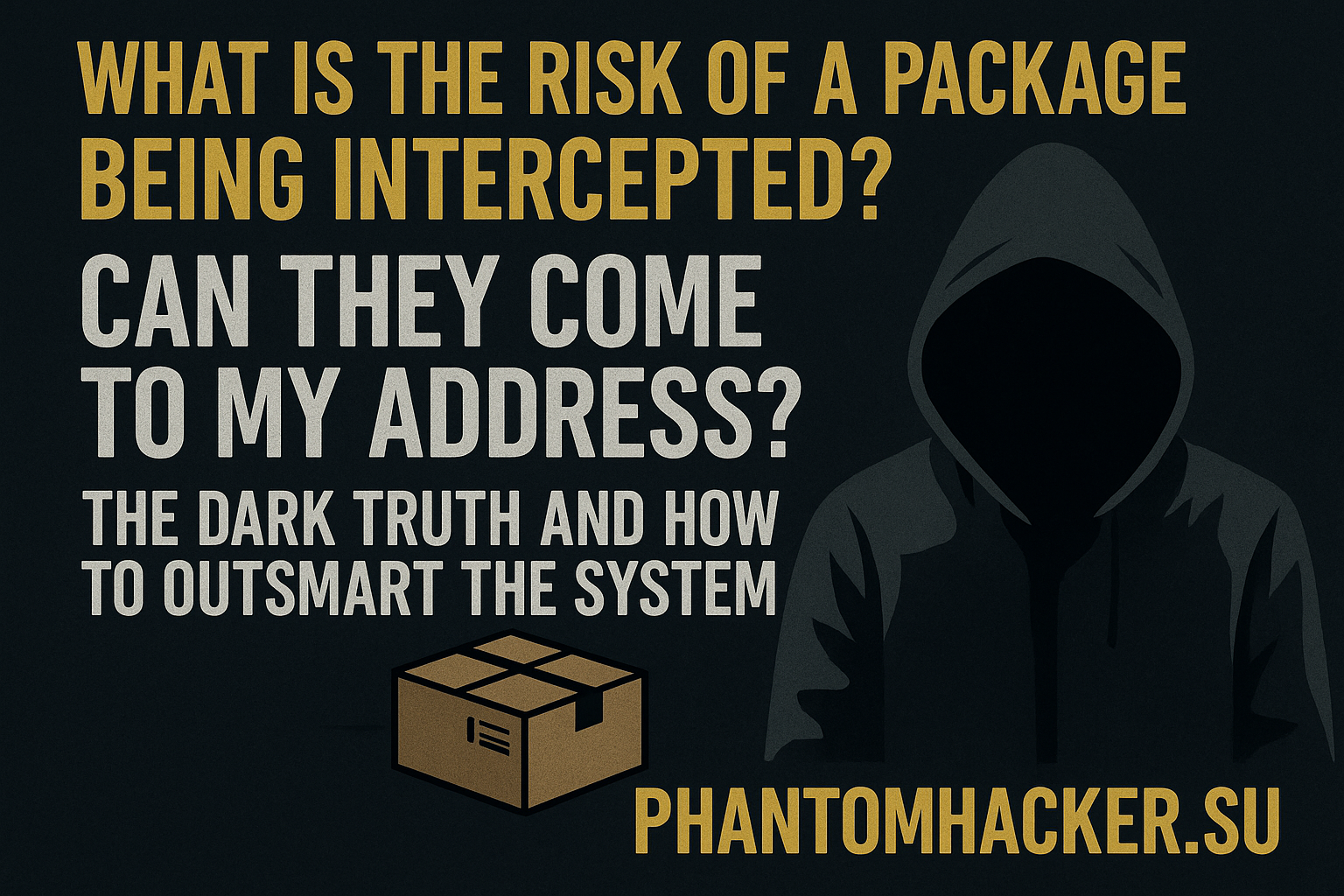Welcome to the underground — a place where every shipment is a gamble and every misstep can leave you staring into the cold eyes of law enforcement. If you’ve ever wondered about the real risks of a package being intercepted — especially when it’s carrying something a little too spicy for your average post office — this isn’t your sugar-coated PSA. This is your crash course in avoiding the federal hammer, backed by dark-web logic, real examples, and a ruthless breakdown of how to survive the game. You asked, “Can they come to my address if the package is intercepted?” Let’s burn through the bullshit and answer that with fire.
The Real Risk of Interception: Know the Battlefield
Let’s be blunt. Every time you order something illicit — be it substances, hardware, counterfeit docs, or otherwise — you’re rolling the dice. Whether the item is legal or questionable, the minute it enters a logistical pipeline, it becomes a data point. It has a barcode, a tracker, an origin, and a destination. And in certain countries, especially ones with aggressive customs policies, that can mean trouble.
So, what’s the interception risk?
Domestic Orders: Low-Risk but Not Bulletproof
Ordering within your own country is typically the safest route. Fewer checks. Less customs scrutiny. Shorter travel time. But don’t let comfort lull you into complacency.
Example: In the U.S., small domestic parcels rarely get flagged unless they’re leaking powder, giving off odor, or look suspect. But USPS does cooperate with the Postal Inspection Service. If your vendor skips stealth packaging, you might just win the “random check” lottery — and lose your freedom.
Pro Tip: Use vendors who take stealth seriously. Tamper-proof seals, vacuum-sealing, and decoys (e.g., electronics boxes, fake toys, retail packaging) are signs of a professional. If your guy’s tossing your product in a Ziploc and praying, drop him.
International Orders: The Razor’s Edge
Now we’re in the danger zone. Customs are bastards. Not because they’re thorough — but because they’re inconsistent. A package might sail through one day, then get torn apart the next for no reason at all. International orders bring a cocktail of complications:
-
Declaration forms (CN22/CN23)
-
X-ray scans
-
Drug dogs
-
Flagged countries of origin (Netherlands, Spain, Eastern Europe, etc.)
If your name and address are on that intercepted parcel, and what’s inside is illegal under local law, you’re officially on thin ice.
What happens next?
-
Small quantities = warning letters, minor fines, or simple confiscation.
-
Medium quantities = police knock, a search warrant, maybe a trial.
-
Bulk quantities = welcome to the penal system.
Real Case: The Fall of a Lazy Buyer
A European buyer ordered two boxes of counterfeit Xanax from a .su domain vendor. Customs in Germany opened it, forwarded it to narcotics division, and the police waited until he signed for it. He answered the door. They answered with cuffs. That’s how stupid it gets.
They Can Come to Your Address — If You Let Them
Don’t believe the fairy tale that a name on a package isn’t enough. Yes, technically, they need more to convict. But here’s the kicker: judges are not robots. They don’t need CSI-grade evidence to hammer down a verdict. A package with your name and address, plus a substance inside — that’s presumptive ownership. In court, that plays against you hard.
And don’t get cocky thinking you’ll just “deny deny deny.” Silence is golden, yes. But even golden statues crack under pressure if your whole operation is sloppy.
How to Minimize the Risk: Cunning Is Currency
If you’re going to dance with the devil, learn the steps. Here’s how professionals keep the odds in their favor:
1. Never Ship to Your Own Address
This is rule one for a reason. Even if you think your opsec is tight, it’s never good enough. Use a drop.
-
Use packing stations, P.O. boxes, or dead drops
-
Find a clueless recipient (a.k.a. a ghost address or return-to-sender box)
-
Rotate locations frequently
Don’t: use your mom’s house. Don’t use your real name. And don’t think your fake name on a real address will hold up in court. It won’t.
2. Use Controlled Intermediaries
Some people run ops where an “unwitting” person (a mule) accepts the package, then passes it to the real buyer. These folks are typically unaware of the content, which gives the buyer a degree of separation if shit hits the fan.
3. Pick the Right Vendor
You’re only as strong as the person mailing your sins. Ask about stealth. Ask about re-ship policies. Ask about decoys. If they get offended, they’re amateurs. The dark web is saturated with half-assed “vendors” who act like they’re above scrutiny. Avoid them like the plague.
Tracking: The Silent Snitch
Let’s talk about obsession — tracking numbers. They’re addictive. Every refresh is a dopamine hit, but every visit to a tracking site pings your IP, logs your browser fingerprint, and puts a digital tail on your curiosity.
Use international multi-trackers like 17track. They strip out some of the metadata. Better yet, use Tor with JS disabled or a burner device with a VPN. And don’t check more than once a day.
Also, never sign up for tracking email alerts using your real email. Basic hygiene, people.
What to Do If It Gets Seized: The Cold Response
Your package is flagged. Customs sends a letter. Or worse — police knock at the door. What now?
Don’t Panic. Do This Instead:
-
Say Nothing. Anything you say can and will be twisted against you. Lawyers exist for a reason.
-
Don’t confess, don’t speculate, don’t joke. Keep your mouth shut. That’s your superpower.
-
Don’t call the vendor crying. The feds monitor everything once you’re in play.
-
Lawyer up. Even if it’s “just a small thing,” always be prepared to go full legal pitbull mode.
Smart Shipping: Black-Belt Moves
Let’s go advanced. Want to ship like a ghost? Here are the boss-level tactics:
-
Use neutral return addresses — like random businesses
-
Avoid using names that link to your darknet handles
-
Pad inside boxes with extra items (e.g., stuffed animals) to obscure weight
-
Shield from x-rays using carbon paper or lead-lined bags (careful: that alone can get it flagged)
-
Avoid regular patterns. Never same day, same time, same location
Closing Thoughts: There’s No Such Thing as Zero Risk
This game is about mitigation, not elimination. If you’re in this world, accept that you’re playing chess against a faceless machine. It’s patient. It’s methodical. And it only needs you to screw up once.
You can wear a digital mask, encrypt your chats, buy the cleanest logs, and still fall if you let your ego write checks your setup can’t cash.
So here’s the truth no one else will give you — if you’re not ready to go full ghost, you’re already a target. Get smart. Get ruthless. And above all, get out if you can’t handle the burn.
Final Word: The risk is real. The system is rigged. But the smartest predators don’t fight the jungle — they blend in until they strike.
Stay anonymous. Stay strategic. And never forget: the real war isn’t on the streets, it’s in the shipping lanes.
Written for cybersecurity research and educational purposes.








